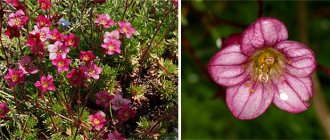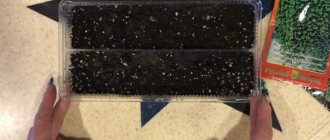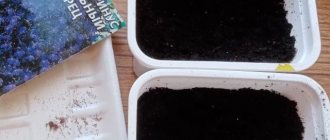Saxifraga is a ground cover perennial herbaceous unpretentious crop. In regions with cold winters it is grown as an annual. There are plants with pink, red, purple, yellow, and white flowers. It also has other names: Saxifraga, Rupture-grass. Such unusual names were obtained due to the fact that the flower crop can literally destroy rock. The most popular type: Saxifraga Arends (height about 10-20 cm), the species blooms, as a rule, in late spring, early summer, is winter-hardy and unpretentious, but does not tolerate drying out of the soil. In terms of care, Arends saxifrage is very unpretentious, you just need to water it periodically, preventing the soil from drying out. Loves open areas with loose, well-drained soil, but can be grown in light partial shade.
What do saxifrage seeds look like?
Photos of saxifrage seeds show that the grains are small in size, no more than 1 mm. Their shape is round, with a slight point at the tip, the shell is dark and hard.
Saxifraga from seedlings is a perennial ground cover up to 20 cm tall. It has flexible thin stems and carved leaves and bears red, yellow or white flowers. It quickly spreads throughout the area, for which it is valued by gardeners - with the help of the crop you can quickly cover empty lawns.
PREPARATION OF SOIL FOR SOWING
While the seeds are gaining strength to grow, you need to take care of preparing the substrate for sowing. This can be done in two ways: prepare the substrate in advance and sow it, or use peat tablets.
In the first case, you need to purchase special soil in advance or make the mixture yourself. To do this you need to mix:
- sand – 1 tsp.
- peat soil – 2 hours.
- vermiculite – 0.5 tsp.
- lime (chalk) – 0.1 tsp.
All varieties of this plant require calcium. This is necessary for garden species, since they grow wild on soils rich in carbonates. Chalk or limestone will contribute to full development. For the second method, tablets are required at the rate of 2-3 seeds per tablet.
The prepared seeds are distributed over the surface of the container with soil, trying to do it as evenly as possible. The seeds do not need to be buried or covered with a substrate. If the soil mixture is dry, it should be moistened with a spray bottle. To avoid mold from excess moisture, containers must be equipped with holes.
Containers with crops must be covered with translucent material (film, glass, transparent lid) and sent to a bright place at 18-20 C. The container must be ventilated and condensation removed at least 2 times a day. There is no need for watering during seed germination. After the first shoots begin to appear, the covering material is removed. This must be done gradually so that the plant acclimatizes.
If you follow the growing technology, the seeds will begin to hatch from 7 to 15 days.
When to sow saxifrage seeds for seedlings and in open ground
To properly sow saxifrage for seedlings, you need to choose the appropriate timing. Usually the crop is planted in mid- or late March at home. First, the perennial seeds are stratified in the cold - the process should take at least a month.
Planting in open ground is carried out in late autumn just before the onset of cold weather. In this case, the seeds undergo natural stratification during the winter, and in the spring they sprout vigorously immediately after warm weather sets in.
The best ornamental varieties of saxifrage plants
Cultivated varieties of saxifrage can improve the appearance of any area. Ideal for growing in flower beds, in flowerpots, as well as for organizing organized flower beds and large stones. To grow saxifrage in the garden, choose varieties of soddy saxifrage Arends. The best varieties of Arends saxifrage include:
- Variety “Purpurmontel” - plant height does not exceed 20-25 cm. The flowers are medium bright, purple-pink in color, forming a very dense green carpet. Blooms in early June. The “Purpurmontel” variety is not afraid of frost; when grown as a perennial plant, it does not require shelter.
- Variety “Snow Carpet” - plant height does not exceed 15 cm. The flowers are medium bright, white, forming a dense green carpet. Blooms in mid-May. The “Snow Carpet” variety forms a dense cushion up to 3-5 cm in height. Ideal for decorating rocky areas.
- Variety "Flora Carpet" - plant height no more than 20 cm. The flowers are medium-sized, white-pink. Blooms beautifully on alpine hills. Blooms in early June. The "Flora Carpet" variety forms a dense cushion up to 3-5 cm in height. The only variety that prefers to grow on the sunny side of the site
- Variety “Flamingo” - plant height no more than 20 cm. The flowers are medium-sized, white-pink. Planted in small groups in garden plots and flower beds. Blooms in early June.
The Flamingo variety is most often grown as a perennial plant. Winter-hardy variety.
How to grow saxifrage from seeds
Planting saxifrage seeds and caring for it is not associated with great difficulties. Most often, during the spring, the perennial is grown in seedlings, and then transferred to open soil.
Growing conditions
To plant saxifrage from seeds for cultivation, you need to prepare a wooden or plastic container with sides no more than 10 cm high. Drainage holes are made at the bottom of the container, and then scalded with boiling water for disinfection.
The crop needs nutritious and loose soil. To prepare it, lowland peat, vermiculite and river sand are mixed in a ratio of 6:2:1. Like containers, the soil must be disinfected before planting seeds; a solution of potassium permanganate can be used for this purpose.
Since saxifrage loves calcium very much, lime or chalk is also added to the substrate
Stratification of saxifrage seeds
When grown, perennial seeds germinate rather slowly, so they need to be stratified before planting. In mid-February or early March, the grains are mixed with clean river sand on a saucer and generously sprayed with a spray bottle. After this, the dishes are placed in a plastic bag, tied and placed in the refrigerator.
From time to time, the seeds are opened for ventilation and, if necessary, re-moistened. Planting material needs to be stratified within 1-1.5 months.
How to plant saxifrage seeds for seedlings and in open ground
Videos about sowing saxifrage seeds for seedlings show that the algorithm consists of several stages. The procedure is carried out as follows:
- Place perlite or expanded clay on the bottom of the growing container in a layer of 2-3 cm.
- Fill the container with substrate and level its surface.
- Moisten the soil generously with a spray bottle.
- After stratification, the seeds are mixed with a fresh portion of river sand.
- Grains are sown evenly over the surface of the substrate.
- Spray again.
There is no need to bury the seeds when planting or sprinkle them with soil on top. The container is covered with film or a piece of glass, and then placed in a warm room with moderate lighting.
The optimal temperature for growing saxifrage from seeds is 22 °C
Caring for seedlings and planting in open ground
Until the first shoots appear, the box with seedlings is kept under film or glass and ventilated daily. As soon as green sprouts appear, remove the cover and move the container to a lighted windowsill.
Further care comes down to carefully moistening the seedlings with a spray bottle as the soil dries. When the seedlings have 2-3 true leaves, they will need to be planted in plastic or peat cups. After this, the seedlings are protected from the bright sun for 3-4 days for quick establishment, and then they continue growing according to the previous scheme.
It is necessary to transfer seedlings into the ground in the second half of May, when the soil warms up and recurrent frosts have passed. The area for planting and growing the crop should be moderately lit, with light shading. The soil must be alkaline in composition and fertile; if necessary, it must be preliminarily limed.
Attention! With proper planting, saxifrage sprouts after 1-2 weeks of cultivation.
It is recommended to transfer the perennial into the ground using the transshipment method. In the selected area, several holes are dug, which should be approximately three times the size of the plant’s root system. After this, the seedlings are planted in prepared holes along with an old lump of earth. Plants are watered and mulched generously to slow down water evaporation.
When planting saxifrage in a growing area, you need to leave 20 cm between individual seedlings from seeds.
Aftercare
After planting saxifrage from seeds in open ground in the spring, it is necessary to provide the perennial with quality care. It comes down to several procedures:
- Watering. It is necessary to moisten saxifrage moderately as the top layer of soil dries. During periods of drought, spraying is also recommended. But they are not performed at the height of the day, but only in the evening or morning.
- Feeding. Three times per season, when growing, the crop is fertilized with potassium-phosphorus mixtures. For the first time, fertilizing is applied a couple of weeks after planting in open ground, and then during budding and during flowering.
- Mulching. To make saxifrage less susceptible to drought and weeds, it is recommended to sprinkle the soil under it with wood chips or sawdust. You can also use gravel or expanded clay.
- Trimming. When growing saxifrage, dried inflorescences are removed to free up resources for new buds. At the end of the decorative period, you can cut off the entire above-ground part - this stimulates the growth of fresh leaves.
Before the onset of winter, the perennial is covered with spruce branches or straw in a layer of at least 10 cm. This will protect the plant from wind and frost.
Advice! After snow falls, a dense snowdrift can be built over the saxifrage. It will also help insulate the perennial.
Reproduction of saxifrage
Propagation by seeds
Every plant has its own secret, saxifrage is no exception. Its main secret is cold treatment of seeds, which guarantees good germination.
Starting in April, gardeners begin the procedure for processing seeds for planting:
- The moist soil is placed in a flat container, and the seeds are laid on top and left in the refrigerator for 14-20 days.
- The seedlings are moved from the refrigerator to the windowsill of a well-lit window and covered with film (the temperature inside the greenhouse should be +18 - +20 degrees), small black seeds germinate in 7-8 days.
- After the first shoots, the film is lifted for air circulation.
- It is necessary to wait for strong leaves and move the seedlings into large boxes.
When propagated by seeds, saxifrage blooms for the first time in the second year.
Propagation by cuttings
The procedure is done in any season except winter:
- A single rosette of leaves is cut off at the base of the stem, the lower leaves are removed and placed in a container with sand.
- Leave for rooting in a cool place where there are no drafts;
- Rooted cuttings are transplanted into a pot, and after a few weeks - outside.
The cuttings are planted in non-acidic drainage soil; you can use sterilized garden soil.
Reproduction by dividing the bush
It is necessary to wait until the plant has completely bloomed:
- Prepare holes (size and depth depend on the size of the saxifrage for division). Remove all the soil from the hole, mix with sand, compost, fine limestone, and place drainage on the bottom.
- In order for the bush to be easily dug up and divided into parts without damaging the roots, it must be watered beforehand. Divide so that each part has mature roots and green mass.
- Plant immediately in the prepared holes, lightly compacting the soil, and water.
Gardeners choose this type of propagation most often, but only those who already have saxifrages that have taken root on the site.
Recommendations and common mistakes
When growing saxifrage from seeds, you must follow important rules. This will allow you to avoid serious mistakes that can destroy the plant:
- When growing, saxifrage should not be over-watered. The soil should always remain slightly moist, but not waterlogged, otherwise the perennial roots will begin to rot.
- After planting saxifrage seeds at home, it is necessary to carefully control the temperature in the room. In conditions above 25 °C the plant will begin to stretch and weaken.
- Watering and spraying the crop cannot be done during the daytime in clear weather, as this will lead to burns of the roots and leaves. Procedures are performed only on cloudy days or in the evening and morning, when there is no bright sun.
When growing saxifrage after planting in open ground, you need to carry out rejuvenating procedures for the plant every 4-5 years. An adult bush is dug out from the old place, divided into several parts and transferred to new holes. Without rejuvenation, old saxifrage stops blooming and loses its attractiveness.
Before planting, it is recommended to treat saxifrage seeds with a weak manganese solution for disinfection.
Saxifraga care
The main rule for a gardener in caring for a plant is knowledge of the chosen species and the features of caring for it. Do not forget that some saxifrages love moisture and shade, others love the sun and a certain soil composition.
In order for the plant to look healthy and provide timely pleasure with beautiful flowers, the gardener is strongly recommended to study all the information on the specifically chosen species:
- The plant dies when exposed to direct sunlight, and the temperature should be: 20-25°C for summer, 12-18°C for winter.
- In spring and summer, it is recommended to spray saxifrage with the same water as for irrigation.
- After flowering, to maintain a decorative appearance, all remnants of flowers and stems are removed.
- Before winter, the bushes are covered with spruce branches and dry leaves.
When growing in a garden, care begins much earlier than the appearance of the plant itself: it is necessary to build a hill with drainage in advance, then properly grow, plant, and care for it.
Watering
Water is used that is settled, soft, and warm. Rainwater is perfect.
From spring until autumn, water in a moderate mode (the top layer of soil dries out - add water). In winter, only indoor saxifrages are occasionally irrigated so that the earthen ball does not dry out.
Fertilizers
Mineral fertilizers are added to water for irrigation. Various organic fertilizers (bone meal) and superphosphate are suitable for saxifrage. It is not recommended to use nitrogen fertilizers.
Top dressing
They feed all year round only if the plant lives in an apartment or winter garden. For feeding, take a liquid consistency or fertilizer solution.
Refill quantity:
- In spring, summer - every 14 days.
- In autumn - every 45 days.
- In winter - every 60 days.
Stop watering and feeding street crops before frosts.
Transfer
Reasons for transplantation:
- The plant has “grown” and requires more space.
- The composition of the soil has deteriorated.
- The plant lived in one place for more than six years.
- Part of the group is infected with some disease.
Composition of the substrate for replanting:
- Acidity: approximately 6 (pH), drainage is placed at the bottom of the hole/pot.
- Land – 1 part.
- Turf – 2 parts.
- Sand – ½ part.
You can prepare the above mixture by adding 1 part each of compost and peat. Mix all ingredients thoroughly.
Diseases and pests
It rarely gets sick, but if you do not care for it properly and do not carry out preventive measures, then there is a risk of losing a large amount of saxifrage.
Its main “enemies” are:
- Fungal infection.
- Spider mite.
- Mealybugs.
- Aphids: The insect comes in white, green and brown colors.
- “Powdery mildew” - with this disease, the leaves are powdered with a white coating.
- “Rust” appears as brown or yellowish spots on the leaves.
- Incorrect watering, lighting, temperature.
If, without any visible signs of pests, the plant suddenly stops growing, turns pale (too much moisture), becomes covered with dry spots (sunburn), and the leaves become spotted - re-read the information about proper care for this variety of saxifrage.
Care during and after flowering
During the period of release of inflorescences, it is useful to fertilize and increase the amount of potassium and phosphorus. Loosening and timely watering are also required. Faded buds are removed from the bush. If the grower plans to collect seeds, then he needs to wait until the fruit-box ripens, from which the planting material is taken out, dried, and put into paper bags for storage.
After flowering, you need to take care of the formation of new leaf blades. The above-ground part is cut off to stimulate vegetation in the new season. The plant overwinters in the ground, but requires shelter from a large number of fallen leaves and spruce branches.
Saxifraga in landscape design
With its mesmerizing beauty, saxifrage has earned its rightful place in modern landscape design. It is placed in rock gardens, on artificial slides, embankments and rocks, where it looks very stylish and impressive. This plant will instantly turn an empty and unattractive rocky place into a chic flower garden. The richness of its varieties and shades will fill the surrounding space with bright, rich colors. That is why saxifrage is absolutely irreplaceable for landscape design.
Diseases and pests
Saxifraga is quite resistant to pests and diseases. However, unfavorable growing conditions or improper care can cause it to become infected or damaged by pests.
Dryness can cause damage to the plant by spider mites. In this case, a whitish web will be visible on the saxifrage. Later, the mite infects the leaves, they become covered with yellow spots, dry out and gradually die. Excessive moisture leads to the appearance of powdery mildew or damage to the leaves of the plant by rust, which is created by a variety of fungi.
Spider mite
The most dangerous pests for these perennial plants are scale insects and green aphids.
What can they do in the garden?
The best partners of saxifrages on the hill are dwarf conifers. A rocky garden, consisting almost exclusively of these plants, is beautiful at any time of the year with the shape of the trees and the shades of the pillows and pine needles.
Many non-aggressive perennial “alpines” will also be suitable for company with saxifrages: gentians, carnations, saxifrages, breakers - in general, all lovers of limestone. If you want to try combinations, for example, with heathers (heather, Erica, wild rosemary, rhododendrons) - containers will help!
Prevention
Diseases can be treated in various ways, but it is much easier to prevent their development. To do this, it is important to remember that even the most moisture-loving plant can die from too much water. To treat the most common diseases, such as fungi and rot, you need to carefully examine the plant affected by the disease and carefully separate the damaged parts. There are also some products that help very well in destroying fungus (HOM, topaz, etc.).
Treatment of saxifrage
Arends' saxifrage is a flower for all occasions: both practical to use at home and beautiful for design. If all conditions are followed correctly, the plant will delight residents and guests with its variegated, lush color.
Growing saxifrage: start simple
Unpretentious soddy saxifrage (S. Caespitosa) and Arends (S. arendsii) form soft mats and bloom with white, pink or red flowers on graceful peduncles. With this saxifrage you can practice all the techniques of planting, sowing, cuttings, and then move on to more complex species.
They are magnificent in bloom - they make colorful rugs. Pads without flowers are also good - both consistently green and compact throughout the year. Only old plants can prop up in the middle in winter, and a “bald spot” will appear at the pillow. It is better to rejuvenate such curtains by planting small pieces for rooting.
These saxifrages, introduced into cultivation long ago, have varieties, for example, with semi-double flowers or with very short peduncles.
If it were not for the high growth rate, this saxifrage could be recommended for a rocky garden. However, its place is more likely in the curb, on a retaining wall or near a path, where, despite its low growth, it will not get lost. But if you do plant it among stones, you need to do it away from more delicate plants or periodically trim the edges of the curtain.
The second species that can most often be found among lovers of alpine trifles is paniculate saxifrage (S. paniculata). This is an unpretentious and winter-hardy plant from the mountains of Europe, having rather large rosettes with lime-like outgrowths along the edges of the leaves.
Light, but not heat
Saxifragas should not be planted in direct sunlight, but so that they receive a lot of light, but with protection from the midday heat. A difficult task that can be solved in several ways. Firstly, saxifrage can be planted on the northern, eastern or western side of the rock garden, not at its very top. Then the stones will block them from the sun, and there will be enough light. Secondly, direct light can be blocked by a fairly tall plant located on the south side of the saxifrage. It could be a lumbago bush, for example, or one of the dwarf conifers. Just when planting, maintain a distance so that the leaves of the plants do not fall on the pillow.











